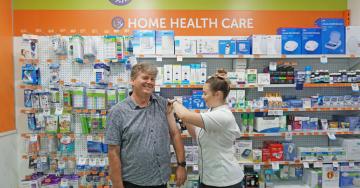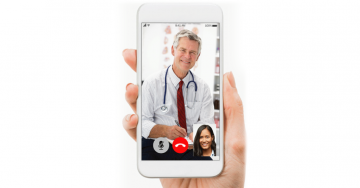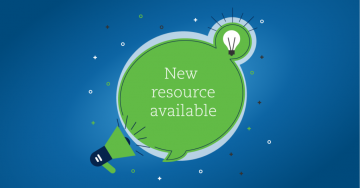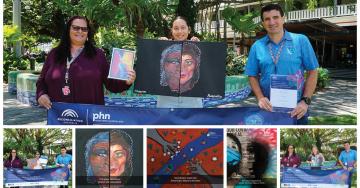How can we help you today?
Telehealth is when you use a phone or video call to talk to your health care worker, like a doctor or nurse. It means you can have a health appointment from anywhere you are, even from home.
If you need to see your GP or specialist, ring the clinic first to see if they offer telehealth appointments. If they do, you’ll be given an appointment time as normal, but instead of going into the clinic you can stay at home and the doctor will call you by phone or videoconference. The medical centre will give you all the details you need.
If your telehealth call is by phone, you just need your landline or mobile phone. Make sure you know which number the doctor will be calling, and be ready by the phone at your scheduled appointment time.
If your consultation is by videoconference, you’ll need a computer or tablet with built-in or attached camera, microphone and speakers. You might find a headset makes it easier to hear and be heard. You’ll also need a stable internet connection. The medical centre will let you know if there’s anything else you need to have or download before your appointment.
It’s a good idea to make sure everything is working a day or two before your telehealth consultation.
If your doctor decides you need to see someone in person after your phone or video consultation, they’ll let you know. They’ll also refer you for any other tests you might need and will let you know how and where these will be carried out.
If you need a prescription, this will normally be sent directly to your local pharmacy for you to collect, following your telehealth appointment.
Influenza (flu) vaccination is the most important measure to prevent the flu and its complications and is recommended for all people aged six months and over.
For the most current influenza information, please refer to Queensland Health 2021 influenza vaccination guidelines.
There’s a lot of information available online, along with resources for detecting and preventing the spread of COVID-19. Sometimes it can be hard to know where to look. If you’re feeling unwell, this can be particularly stressful. If you require medical advice or have queries about COVID-19, the following phone numbers may be of assistance:
- National Coronavirus Helpline: 1800 020 080 (24 hours a day, 7 days a week)
- 13 HEALTH (13 432 584) – general medical advice
Healthdirect Australia has also developed a COVID-19 Symptom Checker – an online self-guided tool which helps people decide if and when they need to seek medical help
It is safe to see your doctor, even during COVID-19. Staying home is important right now, but it is also important that you keep in touch with your health care team – health services are open and here to help.
It’s very important that you continue to visit your regular GP (doctor) during the COVID-19 pandemic, either via telehealth appointments or in person, in order to stay well and healthy. For people with chronic health conditions, parents of young children, people who are pregnant and for general preventative healthcare, it is vital to stay connected with your GP.
The risk of contracting COVID-19 while visiting the doctor in person is very low, and medical centres are taking precautionary measures to help protect their patients and staff. Many clinics are also offering telehealth services as an alternative to in-person consultations for some appointments. When booking your appointment with your doctor, discuss with the practice whether it is best to have this appointment face to face or via telehealth.
It is important to keep taking your regular medications. Contact your doctor or your local pharmacy to make sure your scripts are up to date and to make sure you do not run out of any medications.
Your GP is there to help you follow your treatment plan and improve your health. We want you to stay well during these challenging times. Your health care needs don’t need to take a back seat because of COVID-19. If you have any concerns or aren’t sure if you should see your doctor, ring your medical centre for advice.
- If you go out, keep your distance (1.5m)
- Practice good hygiene – wash your hands with soap and water, or use hand sanitiser
- Leave a location if it is crowded, or wear a mask when you can’t keep your distance
- If you are sick, please stay at home
- If you have symptoms, no matter how mild, get tested
- Find your nearest COVID-19 testing clinic here
- You must go straight home after your test. You need to stay home until you get a negative test result and your symptoms resolve.
There is a lot of confusion about what self-isolation specifically means, and the implications it might have for other members of your household.
The Public Health Incident Management team at Queensland Health have created a factsheet to answer all those tricky questions. For more information, check out the Department of Health website.
The Australian Government has released the COVIDsafe app to help contain and prevent the spread of COVID-19 within Australia.
The app helps find close contacts of COVID-19 cases so it is easier to track and respond to outbreaks of the virus.
Learn more about the COVIDsafe app here.
To make sure you’re getting the right information about COVID-19, always check with a reliable source such as Healthdirect, Queensland Health, or the Australian Department of Health. Be careful with any information shared with you on social media, and don’t share it with others unless it you’re sure it checks out.
Scammers are also using COVID-19 to target people with coronavirus-related scams and phishing emails. If you receive a COVID-19-related email or SMS (text message) asking you to click on a link and enter personal information, only do so if you’re certain it is genuine.
Check Stay Smart Online for more information, and always follow these simple steps:
- Read the message carefully, and look for anything that isn’t quite right, such as tracking numbers, names, attachment names, sender, message subject and hyperlinks.
- If unsure, call the organisation on their official number, as it appears on their website and double-check the details or confirm that the request is legitimate. Do not contact the phone number or email address contained in the message, as this most likely belongs to the scammer.
- Use sources such as the organisation’s mobile phone app, web site or social media page to verify the message. Often large organisations, like Australia Post, will have scam alert pages on their websites, with details of current known scams using their branding, to watch out for.
If you’ve received one of these messages and you’ve clicked on the link, or you’re concerned your personal details have been compromised, contact your financial institution immediately.







